Case Study of Sarah: Exploring Child's Play, Learning & Development
VerifiedAdded on 2023/06/13
|18
|3423
|489
Case Study
AI Summary
This case study explores the play, learning, and development of a two-year-old child named Sarah, focusing on her peer interactions in group play. Sarah, an Australian-born child of Indian parents, demonstrates positive emotional and social development through her interactions. The study employs observation, questionnaires, and interviews to gather data on Sarah's activities, family background, and social relationships. The analysis draws on Lev Vygotsky's theory to highlight the importance of social interaction in cognitive development. Recommendations include providing children with proper diet, love, care, and protection from traumatic events to support healthy development. The case study concludes that child's play, learning, and development are essential factors for growth, influencing social skills and cognitive abilities.

Running head: CHILD’S PLAY AND DEVELOPMENT 1
Child’s play and development
Name
Institution
Professor
Course
Date
Child’s play and development
Name
Institution
Professor
Course
Date
Paraphrase This Document
Need a fresh take? Get an instant paraphrase of this document with our AI Paraphraser
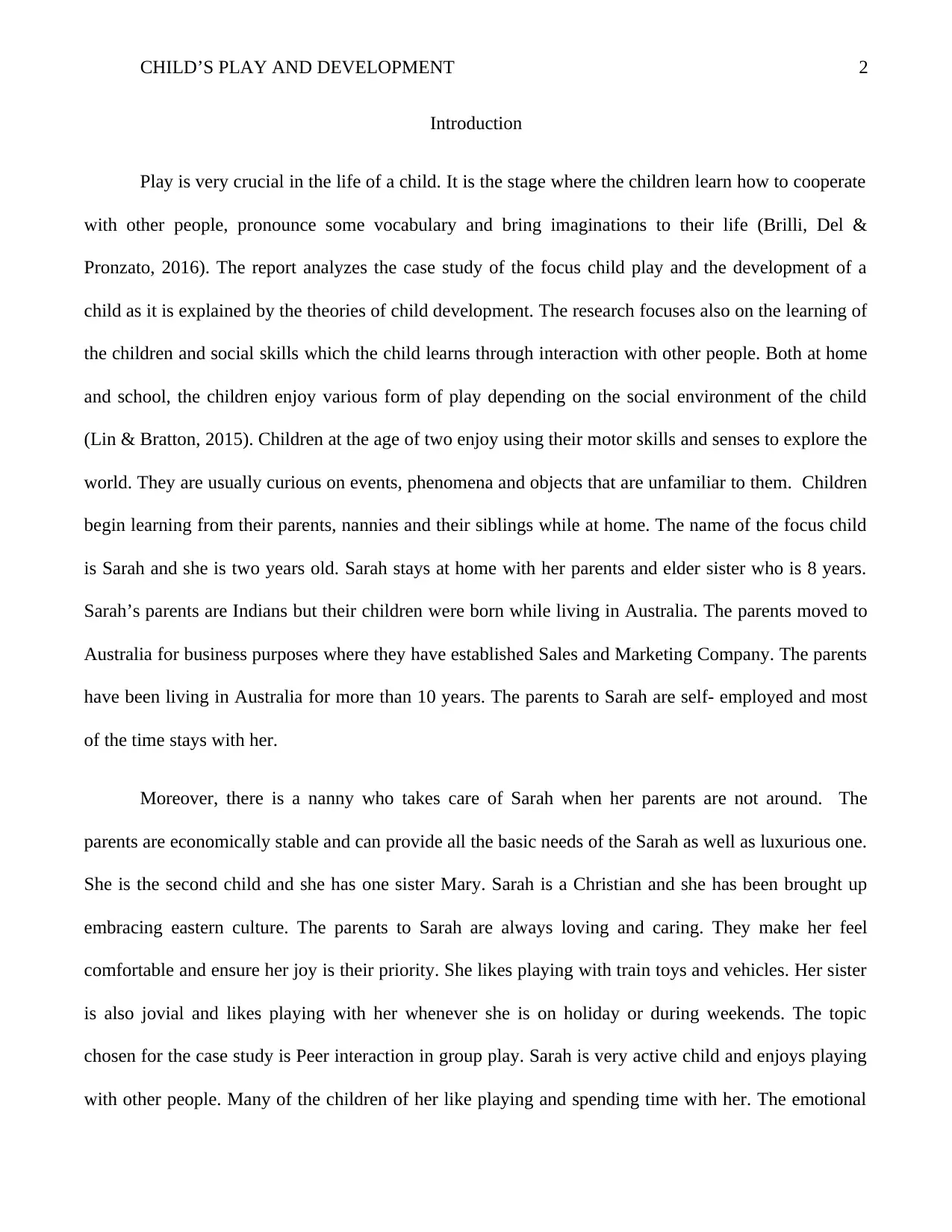
CHILD’S PLAY AND DEVELOPMENT 2
Introduction
Play is very crucial in the life of a child. It is the stage where the children learn how to cooperate
with other people, pronounce some vocabulary and bring imaginations to their life (Brilli, Del &
Pronzato, 2016). The report analyzes the case study of the focus child play and the development of a
child as it is explained by the theories of child development. The research focuses also on the learning of
the children and social skills which the child learns through interaction with other people. Both at home
and school, the children enjoy various form of play depending on the social environment of the child
(Lin & Bratton, 2015). Children at the age of two enjoy using their motor skills and senses to explore the
world. They are usually curious on events, phenomena and objects that are unfamiliar to them. Children
begin learning from their parents, nannies and their siblings while at home. The name of the focus child
is Sarah and she is two years old. Sarah stays at home with her parents and elder sister who is 8 years.
Sarah’s parents are Indians but their children were born while living in Australia. The parents moved to
Australia for business purposes where they have established Sales and Marketing Company. The parents
have been living in Australia for more than 10 years. The parents to Sarah are self- employed and most
of the time stays with her.
Moreover, there is a nanny who takes care of Sarah when her parents are not around. The
parents are economically stable and can provide all the basic needs of the Sarah as well as luxurious one.
She is the second child and she has one sister Mary. Sarah is a Christian and she has been brought up
embracing eastern culture. The parents to Sarah are always loving and caring. They make her feel
comfortable and ensure her joy is their priority. She likes playing with train toys and vehicles. Her sister
is also jovial and likes playing with her whenever she is on holiday or during weekends. The topic
chosen for the case study is Peer interaction in group play. Sarah is very active child and enjoys playing
with other people. Many of the children of her like playing and spending time with her. The emotional
Introduction
Play is very crucial in the life of a child. It is the stage where the children learn how to cooperate
with other people, pronounce some vocabulary and bring imaginations to their life (Brilli, Del &
Pronzato, 2016). The report analyzes the case study of the focus child play and the development of a
child as it is explained by the theories of child development. The research focuses also on the learning of
the children and social skills which the child learns through interaction with other people. Both at home
and school, the children enjoy various form of play depending on the social environment of the child
(Lin & Bratton, 2015). Children at the age of two enjoy using their motor skills and senses to explore the
world. They are usually curious on events, phenomena and objects that are unfamiliar to them. Children
begin learning from their parents, nannies and their siblings while at home. The name of the focus child
is Sarah and she is two years old. Sarah stays at home with her parents and elder sister who is 8 years.
Sarah’s parents are Indians but their children were born while living in Australia. The parents moved to
Australia for business purposes where they have established Sales and Marketing Company. The parents
have been living in Australia for more than 10 years. The parents to Sarah are self- employed and most
of the time stays with her.
Moreover, there is a nanny who takes care of Sarah when her parents are not around. The
parents are economically stable and can provide all the basic needs of the Sarah as well as luxurious one.
She is the second child and she has one sister Mary. Sarah is a Christian and she has been brought up
embracing eastern culture. The parents to Sarah are always loving and caring. They make her feel
comfortable and ensure her joy is their priority. She likes playing with train toys and vehicles. Her sister
is also jovial and likes playing with her whenever she is on holiday or during weekends. The topic
chosen for the case study is Peer interaction in group play. Sarah is very active child and enjoys playing
with other people. Many of the children of her like playing and spending time with her. The emotional

CHILD’S PLAY AND DEVELOPMENT 3
and social developments of Sarah have shown positive changes which are indicated by the number of
people who are impressed by her ever smiling face. The development of a child is greatly determined by
the social environment, the experiences gathered while growing and the interaction with other people
(Hillier & Aurini, 2017). The theories of child development explain various ways of through which
children develop and how different children show their developmental reactions. The main aim of the
article is to explore child’s play, learning and development of a child.
Research questions
What are some of the activities that can increase the interaction of a child?
What are some of the things a child learn through interaction with the peers?
Which theory is related to social interaction of children?
How does a child learn about objects, phenomena, and events around him or her?
Methodology
The methods of data collection utilized for this incidence are observation, questionnaires and
interview. Interview as a method of data collection was used to get the information related to the play of
Sarah and how she was interacting with other people. Parents said that Sarah was very active during the
day and she would only sleep for three hours daytime. At night the child would play with her sister till
nine and then she would sleep for more than ten hours. During the interview with Sarah’s parent, they
indicated that Sarah loves train and vehicle toys. Most of her playing materials are comprised of train
and vehicles toys which she enjoys playing with them. Sarah is jovial and many people love to interact
with her. If she is playing alone, many children of his age would join her in the play. She is not selective
in her play because she can play with any child. She has developed good social relation with other
and social developments of Sarah have shown positive changes which are indicated by the number of
people who are impressed by her ever smiling face. The development of a child is greatly determined by
the social environment, the experiences gathered while growing and the interaction with other people
(Hillier & Aurini, 2017). The theories of child development explain various ways of through which
children develop and how different children show their developmental reactions. The main aim of the
article is to explore child’s play, learning and development of a child.
Research questions
What are some of the activities that can increase the interaction of a child?
What are some of the things a child learn through interaction with the peers?
Which theory is related to social interaction of children?
How does a child learn about objects, phenomena, and events around him or her?
Methodology
The methods of data collection utilized for this incidence are observation, questionnaires and
interview. Interview as a method of data collection was used to get the information related to the play of
Sarah and how she was interacting with other people. Parents said that Sarah was very active during the
day and she would only sleep for three hours daytime. At night the child would play with her sister till
nine and then she would sleep for more than ten hours. During the interview with Sarah’s parent, they
indicated that Sarah loves train and vehicle toys. Most of her playing materials are comprised of train
and vehicles toys which she enjoys playing with them. Sarah is jovial and many people love to interact
with her. If she is playing alone, many children of his age would join her in the play. She is not selective
in her play because she can play with any child. She has developed good social relation with other
⊘ This is a preview!⊘
Do you want full access?
Subscribe today to unlock all pages.

Trusted by 1+ million students worldwide
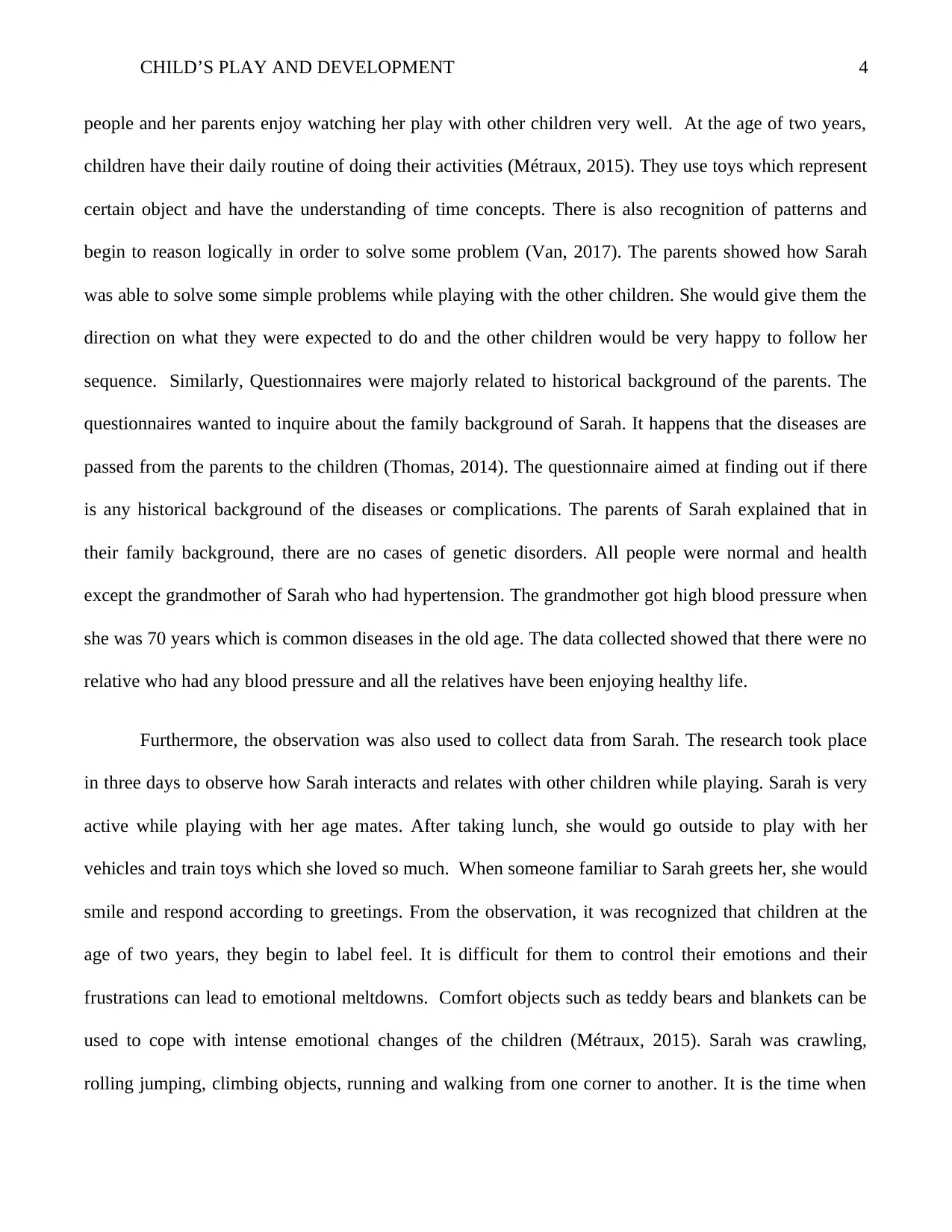
CHILD’S PLAY AND DEVELOPMENT 4
people and her parents enjoy watching her play with other children very well. At the age of two years,
children have their daily routine of doing their activities (Métraux, 2015). They use toys which represent
certain object and have the understanding of time concepts. There is also recognition of patterns and
begin to reason logically in order to solve some problem (Van, 2017). The parents showed how Sarah
was able to solve some simple problems while playing with the other children. She would give them the
direction on what they were expected to do and the other children would be very happy to follow her
sequence. Similarly, Questionnaires were majorly related to historical background of the parents. The
questionnaires wanted to inquire about the family background of Sarah. It happens that the diseases are
passed from the parents to the children (Thomas, 2014). The questionnaire aimed at finding out if there
is any historical background of the diseases or complications. The parents of Sarah explained that in
their family background, there are no cases of genetic disorders. All people were normal and health
except the grandmother of Sarah who had hypertension. The grandmother got high blood pressure when
she was 70 years which is common diseases in the old age. The data collected showed that there were no
relative who had any blood pressure and all the relatives have been enjoying healthy life.
Furthermore, the observation was also used to collect data from Sarah. The research took place
in three days to observe how Sarah interacts and relates with other children while playing. Sarah is very
active while playing with her age mates. After taking lunch, she would go outside to play with her
vehicles and train toys which she loved so much. When someone familiar to Sarah greets her, she would
smile and respond according to greetings. From the observation, it was recognized that children at the
age of two years, they begin to label feel. It is difficult for them to control their emotions and their
frustrations can lead to emotional meltdowns. Comfort objects such as teddy bears and blankets can be
used to cope with intense emotional changes of the children (Métraux, 2015). Sarah was crawling,
rolling jumping, climbing objects, running and walking from one corner to another. It is the time when
people and her parents enjoy watching her play with other children very well. At the age of two years,
children have their daily routine of doing their activities (Métraux, 2015). They use toys which represent
certain object and have the understanding of time concepts. There is also recognition of patterns and
begin to reason logically in order to solve some problem (Van, 2017). The parents showed how Sarah
was able to solve some simple problems while playing with the other children. She would give them the
direction on what they were expected to do and the other children would be very happy to follow her
sequence. Similarly, Questionnaires were majorly related to historical background of the parents. The
questionnaires wanted to inquire about the family background of Sarah. It happens that the diseases are
passed from the parents to the children (Thomas, 2014). The questionnaire aimed at finding out if there
is any historical background of the diseases or complications. The parents of Sarah explained that in
their family background, there are no cases of genetic disorders. All people were normal and health
except the grandmother of Sarah who had hypertension. The grandmother got high blood pressure when
she was 70 years which is common diseases in the old age. The data collected showed that there were no
relative who had any blood pressure and all the relatives have been enjoying healthy life.
Furthermore, the observation was also used to collect data from Sarah. The research took place
in three days to observe how Sarah interacts and relates with other children while playing. Sarah is very
active while playing with her age mates. After taking lunch, she would go outside to play with her
vehicles and train toys which she loved so much. When someone familiar to Sarah greets her, she would
smile and respond according to greetings. From the observation, it was recognized that children at the
age of two years, they begin to label feel. It is difficult for them to control their emotions and their
frustrations can lead to emotional meltdowns. Comfort objects such as teddy bears and blankets can be
used to cope with intense emotional changes of the children (Métraux, 2015). Sarah was crawling,
rolling jumping, climbing objects, running and walking from one corner to another. It is the time when
Paraphrase This Document
Need a fresh take? Get an instant paraphrase of this document with our AI Paraphraser

CHILD’S PLAY AND DEVELOPMENT 5
most of the children can make short complete sentences. They usually have immature skills of
pronunciations and parents have to keenly listen to them to understand what they meant (Veresov,
2018). Sarah could make some sentences though some of them were incomplete and her parent had to
listen carefully to understand what she was saying.
Results and discussion
From the data gathered, cognitive development of a child is crucial in social interactions and
learning. Many children learn recognition of objects and pronunciation of words through social
interaction with their parents, relatives or other children while playing (Kugiumutzakis, 2017). Both
physical and social environment of a child influences the kind of things children think about and their
thinking capacity. Sarah being brought up in a loving and caring environment, she was able to learn new
things very fast. She was able to pronounce most of the English word and could join them to make a
sentence. Lev Vygotsky theory gives consideration to social interaction as they are crucial in the
development of the children. The theory stresses on the impact of the social development especially
cognitive development. Community plays a key role in the enhancement of social development. The
function of human psychology is linked to leaning that is very important universal element in the
development of an organized culture. Social learning of a child begins at early stage of the development.
Sensation, memory, attention and perception can be influenced by other factors such as biological
factors and culture (Cassibba et al, 2015). At early period of child development, he or she is able to use
mental functions that are basic such as memory mnemonics. Learning of the children takes place
through skill tutor and social interactions with other people. Sarah was involved in a cooperative and
collaborative dialogue with her parents, sister and the nanny. A child is always eager to understand the
instructions or actions that are provided by the parent or nannies. The child can internalize the
information provided to regulate or adjust their own performance.
most of the children can make short complete sentences. They usually have immature skills of
pronunciations and parents have to keenly listen to them to understand what they meant (Veresov,
2018). Sarah could make some sentences though some of them were incomplete and her parent had to
listen carefully to understand what she was saying.
Results and discussion
From the data gathered, cognitive development of a child is crucial in social interactions and
learning. Many children learn recognition of objects and pronunciation of words through social
interaction with their parents, relatives or other children while playing (Kugiumutzakis, 2017). Both
physical and social environment of a child influences the kind of things children think about and their
thinking capacity. Sarah being brought up in a loving and caring environment, she was able to learn new
things very fast. She was able to pronounce most of the English word and could join them to make a
sentence. Lev Vygotsky theory gives consideration to social interaction as they are crucial in the
development of the children. The theory stresses on the impact of the social development especially
cognitive development. Community plays a key role in the enhancement of social development. The
function of human psychology is linked to leaning that is very important universal element in the
development of an organized culture. Social learning of a child begins at early stage of the development.
Sensation, memory, attention and perception can be influenced by other factors such as biological
factors and culture (Cassibba et al, 2015). At early period of child development, he or she is able to use
mental functions that are basic such as memory mnemonics. Learning of the children takes place
through skill tutor and social interactions with other people. Sarah was involved in a cooperative and
collaborative dialogue with her parents, sister and the nanny. A child is always eager to understand the
instructions or actions that are provided by the parent or nannies. The child can internalize the
information provided to regulate or adjust their own performance.
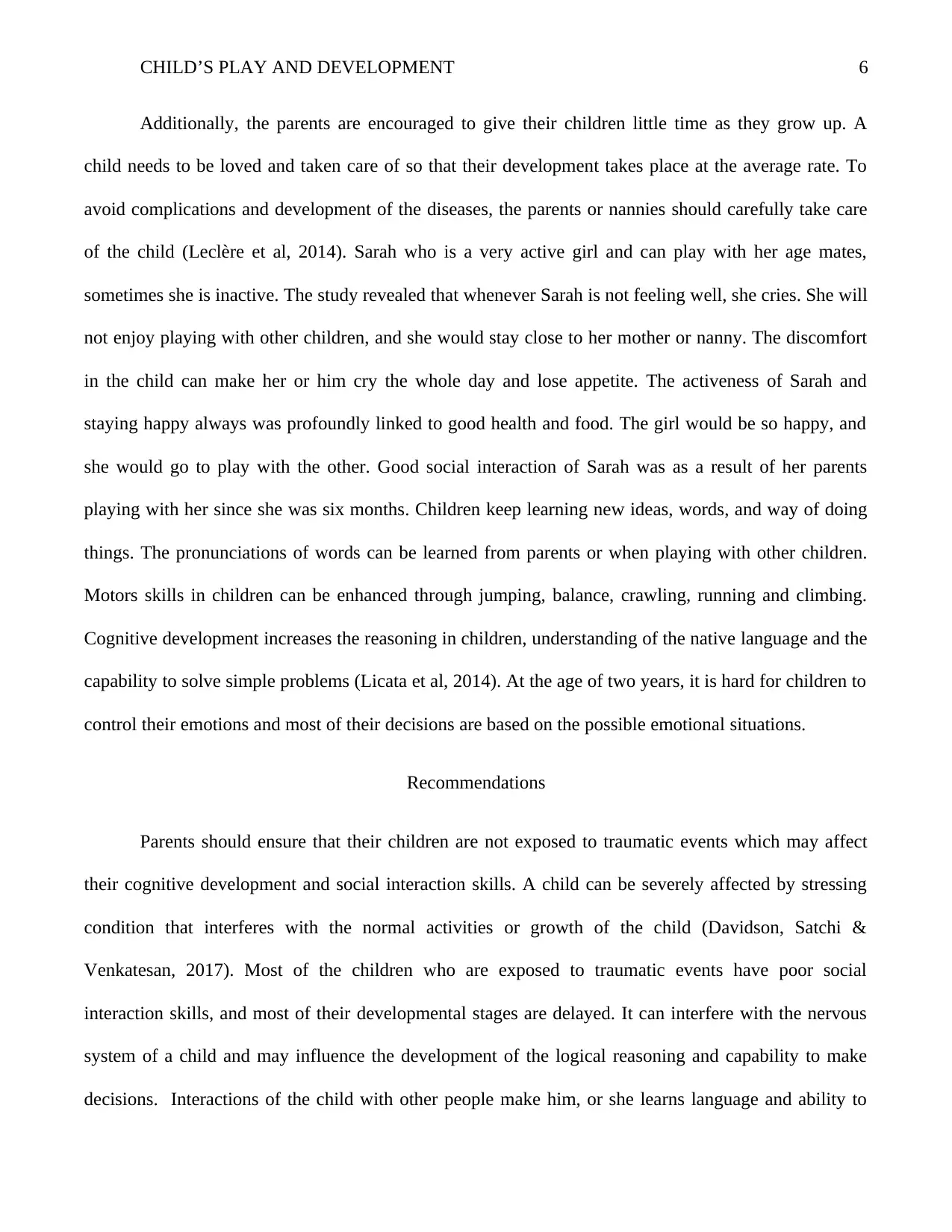
CHILD’S PLAY AND DEVELOPMENT 6
Additionally, the parents are encouraged to give their children little time as they grow up. A
child needs to be loved and taken care of so that their development takes place at the average rate. To
avoid complications and development of the diseases, the parents or nannies should carefully take care
of the child (Leclère et al, 2014). Sarah who is a very active girl and can play with her age mates,
sometimes she is inactive. The study revealed that whenever Sarah is not feeling well, she cries. She will
not enjoy playing with other children, and she would stay close to her mother or nanny. The discomfort
in the child can make her or him cry the whole day and lose appetite. The activeness of Sarah and
staying happy always was profoundly linked to good health and food. The girl would be so happy, and
she would go to play with the other. Good social interaction of Sarah was as a result of her parents
playing with her since she was six months. Children keep learning new ideas, words, and way of doing
things. The pronunciations of words can be learned from parents or when playing with other children.
Motors skills in children can be enhanced through jumping, balance, crawling, running and climbing.
Cognitive development increases the reasoning in children, understanding of the native language and the
capability to solve simple problems (Licata et al, 2014). At the age of two years, it is hard for children to
control their emotions and most of their decisions are based on the possible emotional situations.
Recommendations
Parents should ensure that their children are not exposed to traumatic events which may affect
their cognitive development and social interaction skills. A child can be severely affected by stressing
condition that interferes with the normal activities or growth of the child (Davidson, Satchi &
Venkatesan, 2017). Most of the children who are exposed to traumatic events have poor social
interaction skills, and most of their developmental stages are delayed. It can interfere with the nervous
system of a child and may influence the development of the logical reasoning and capability to make
decisions. Interactions of the child with other people make him, or she learns language and ability to
Additionally, the parents are encouraged to give their children little time as they grow up. A
child needs to be loved and taken care of so that their development takes place at the average rate. To
avoid complications and development of the diseases, the parents or nannies should carefully take care
of the child (Leclère et al, 2014). Sarah who is a very active girl and can play with her age mates,
sometimes she is inactive. The study revealed that whenever Sarah is not feeling well, she cries. She will
not enjoy playing with other children, and she would stay close to her mother or nanny. The discomfort
in the child can make her or him cry the whole day and lose appetite. The activeness of Sarah and
staying happy always was profoundly linked to good health and food. The girl would be so happy, and
she would go to play with the other. Good social interaction of Sarah was as a result of her parents
playing with her since she was six months. Children keep learning new ideas, words, and way of doing
things. The pronunciations of words can be learned from parents or when playing with other children.
Motors skills in children can be enhanced through jumping, balance, crawling, running and climbing.
Cognitive development increases the reasoning in children, understanding of the native language and the
capability to solve simple problems (Licata et al, 2014). At the age of two years, it is hard for children to
control their emotions and most of their decisions are based on the possible emotional situations.
Recommendations
Parents should ensure that their children are not exposed to traumatic events which may affect
their cognitive development and social interaction skills. A child can be severely affected by stressing
condition that interferes with the normal activities or growth of the child (Davidson, Satchi &
Venkatesan, 2017). Most of the children who are exposed to traumatic events have poor social
interaction skills, and most of their developmental stages are delayed. It can interfere with the nervous
system of a child and may influence the development of the logical reasoning and capability to make
decisions. Interactions of the child with other people make him, or she learns language and ability to
⊘ This is a preview!⊘
Do you want full access?
Subscribe today to unlock all pages.

Trusted by 1+ million students worldwide
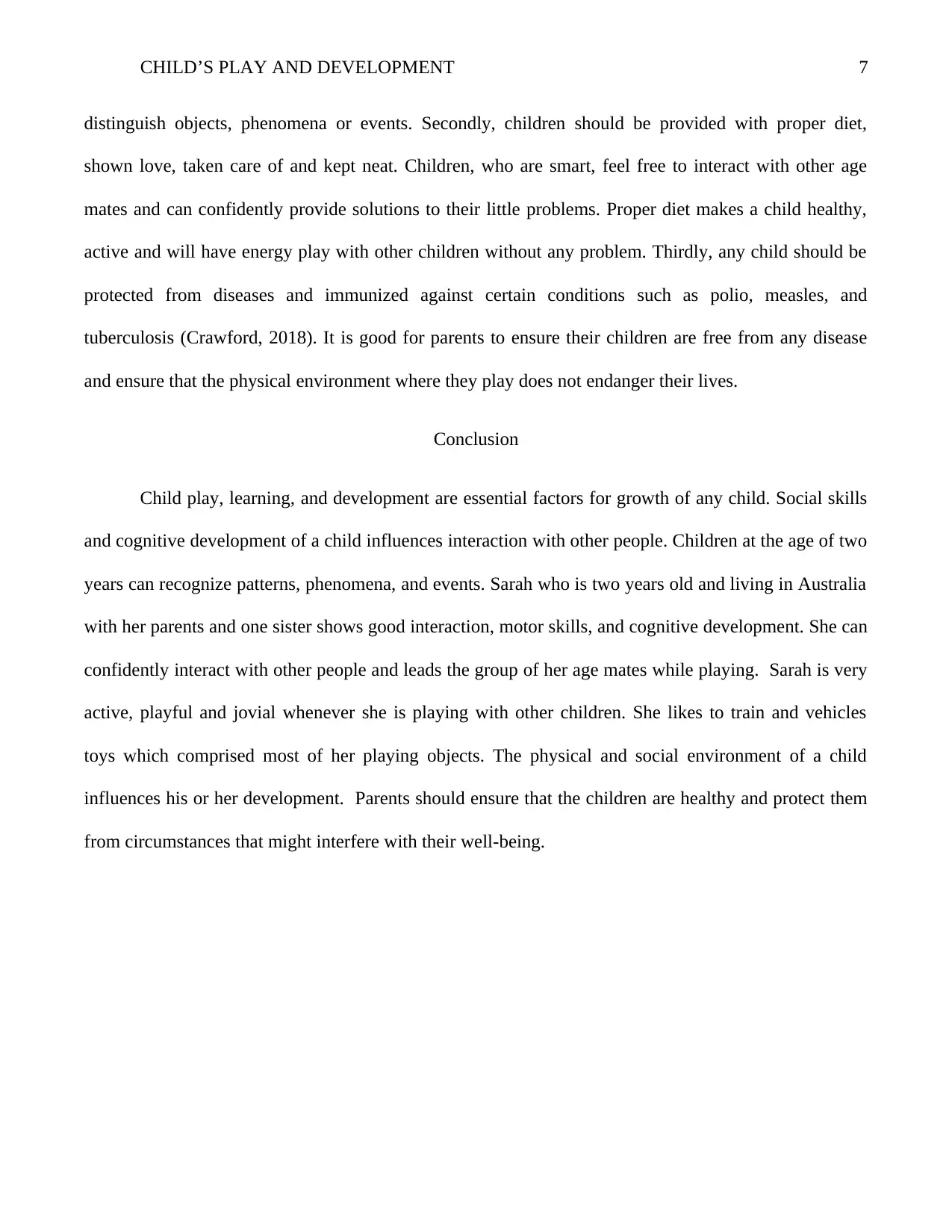
CHILD’S PLAY AND DEVELOPMENT 7
distinguish objects, phenomena or events. Secondly, children should be provided with proper diet,
shown love, taken care of and kept neat. Children, who are smart, feel free to interact with other age
mates and can confidently provide solutions to their little problems. Proper diet makes a child healthy,
active and will have energy play with other children without any problem. Thirdly, any child should be
protected from diseases and immunized against certain conditions such as polio, measles, and
tuberculosis (Crawford, 2018). It is good for parents to ensure their children are free from any disease
and ensure that the physical environment where they play does not endanger their lives.
Conclusion
Child play, learning, and development are essential factors for growth of any child. Social skills
and cognitive development of a child influences interaction with other people. Children at the age of two
years can recognize patterns, phenomena, and events. Sarah who is two years old and living in Australia
with her parents and one sister shows good interaction, motor skills, and cognitive development. She can
confidently interact with other people and leads the group of her age mates while playing. Sarah is very
active, playful and jovial whenever she is playing with other children. She likes to train and vehicles
toys which comprised most of her playing objects. The physical and social environment of a child
influences his or her development. Parents should ensure that the children are healthy and protect them
from circumstances that might interfere with their well-being.
distinguish objects, phenomena or events. Secondly, children should be provided with proper diet,
shown love, taken care of and kept neat. Children, who are smart, feel free to interact with other age
mates and can confidently provide solutions to their little problems. Proper diet makes a child healthy,
active and will have energy play with other children without any problem. Thirdly, any child should be
protected from diseases and immunized against certain conditions such as polio, measles, and
tuberculosis (Crawford, 2018). It is good for parents to ensure their children are free from any disease
and ensure that the physical environment where they play does not endanger their lives.
Conclusion
Child play, learning, and development are essential factors for growth of any child. Social skills
and cognitive development of a child influences interaction with other people. Children at the age of two
years can recognize patterns, phenomena, and events. Sarah who is two years old and living in Australia
with her parents and one sister shows good interaction, motor skills, and cognitive development. She can
confidently interact with other people and leads the group of her age mates while playing. Sarah is very
active, playful and jovial whenever she is playing with other children. She likes to train and vehicles
toys which comprised most of her playing objects. The physical and social environment of a child
influences his or her development. Parents should ensure that the children are healthy and protect them
from circumstances that might interfere with their well-being.
Paraphrase This Document
Need a fresh take? Get an instant paraphrase of this document with our AI Paraphraser

CHILD’S PLAY AND DEVELOPMENT 8
Appendixes
Fig 1:1 Sarah’s smiling
Appendixes
Fig 1:1 Sarah’s smiling
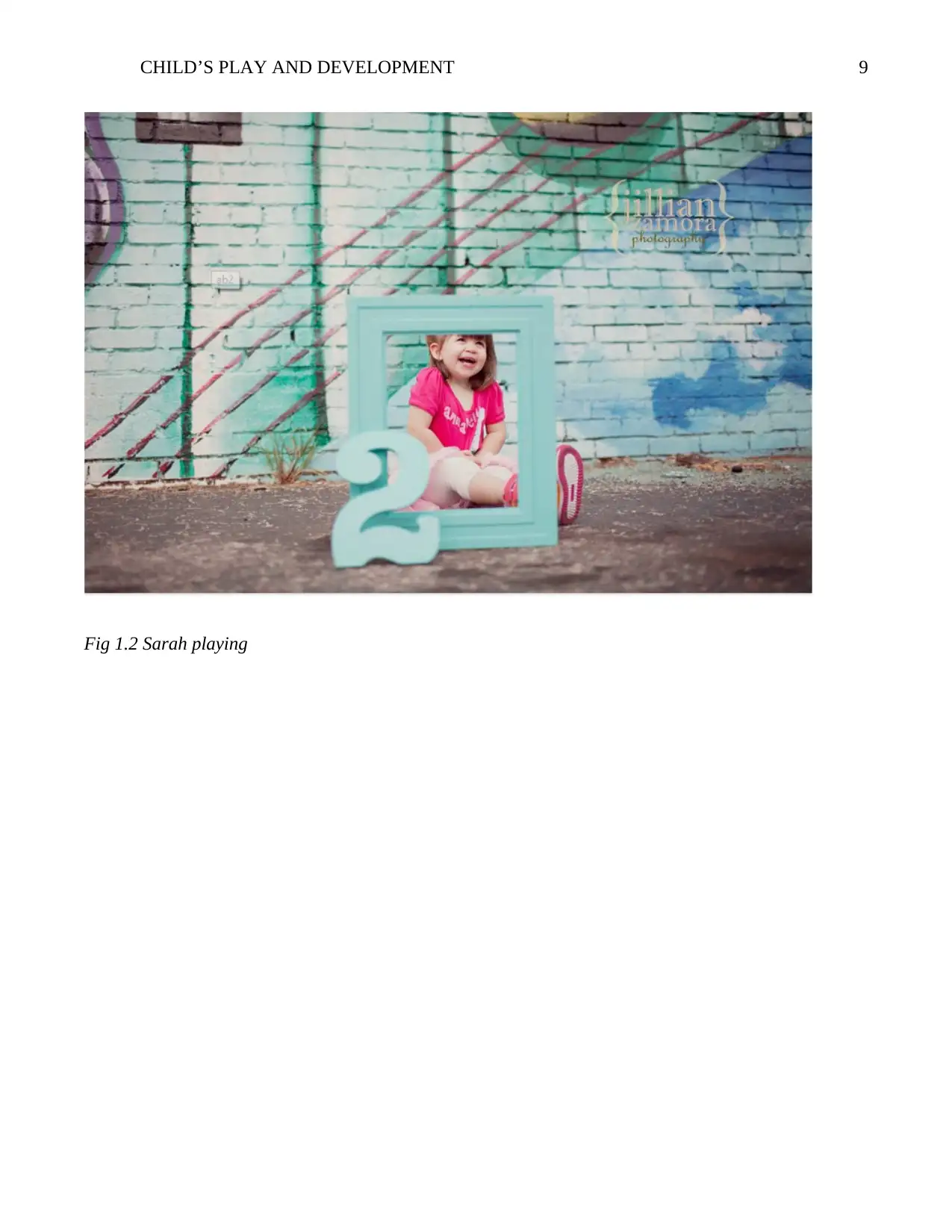
CHILD’S PLAY AND DEVELOPMENT 9
Fig 1.2 Sarah playing
Fig 1.2 Sarah playing
⊘ This is a preview!⊘
Do you want full access?
Subscribe today to unlock all pages.

Trusted by 1+ million students worldwide
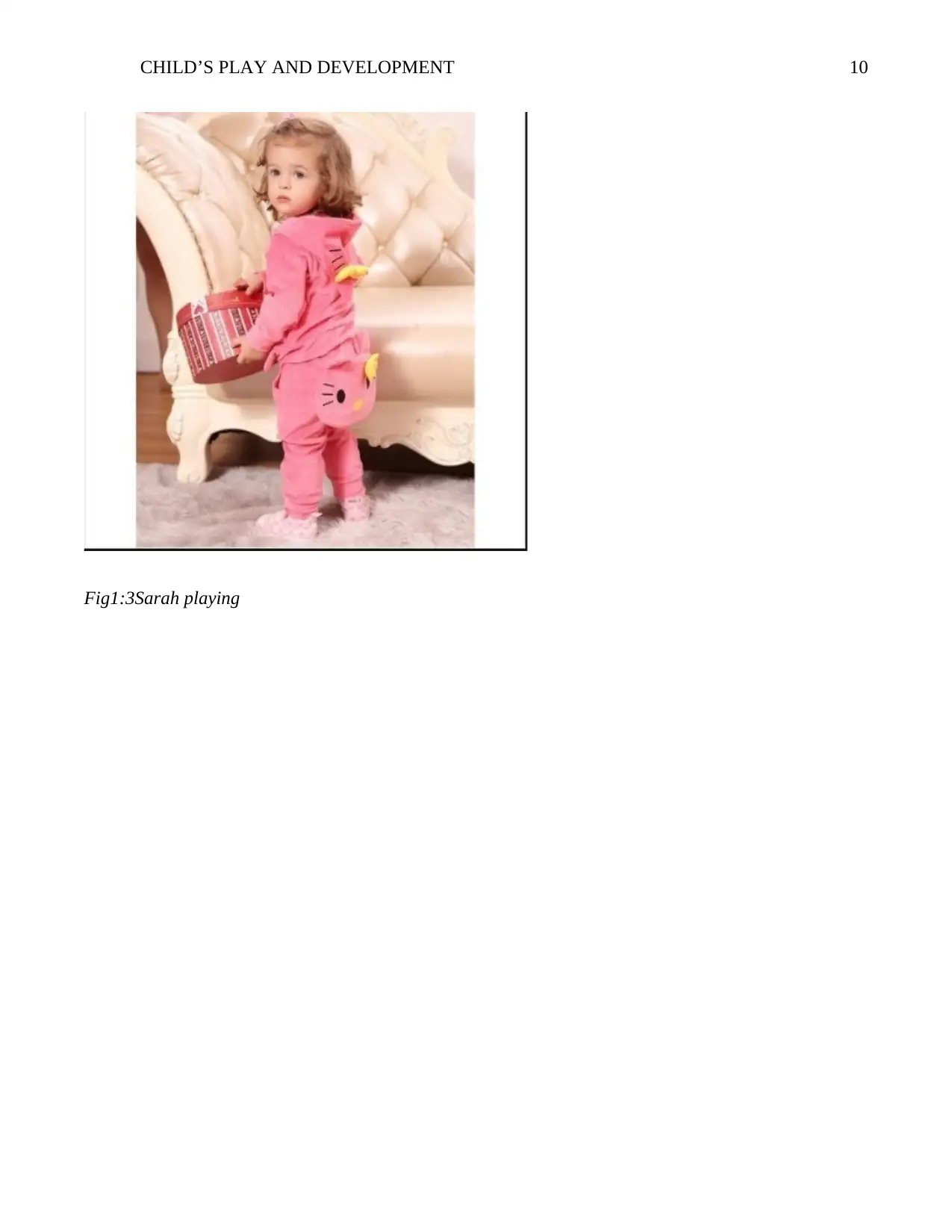
CHILD’S PLAY AND DEVELOPMENT 10
Fig1:3Sarah playing
Fig1:3Sarah playing
Paraphrase This Document
Need a fresh take? Get an instant paraphrase of this document with our AI Paraphraser
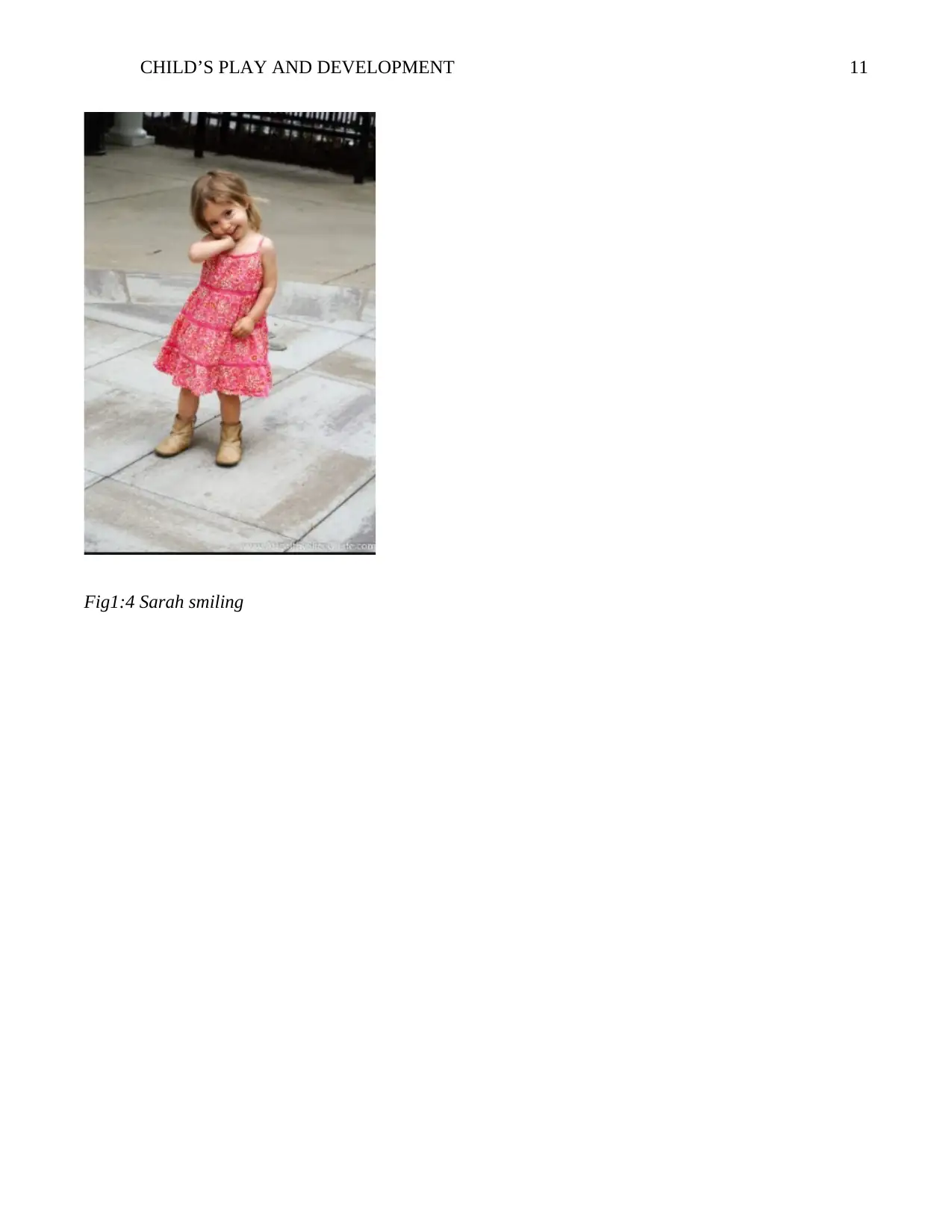
CHILD’S PLAY AND DEVELOPMENT 11
Fig1:4 Sarah smiling
Fig1:4 Sarah smiling
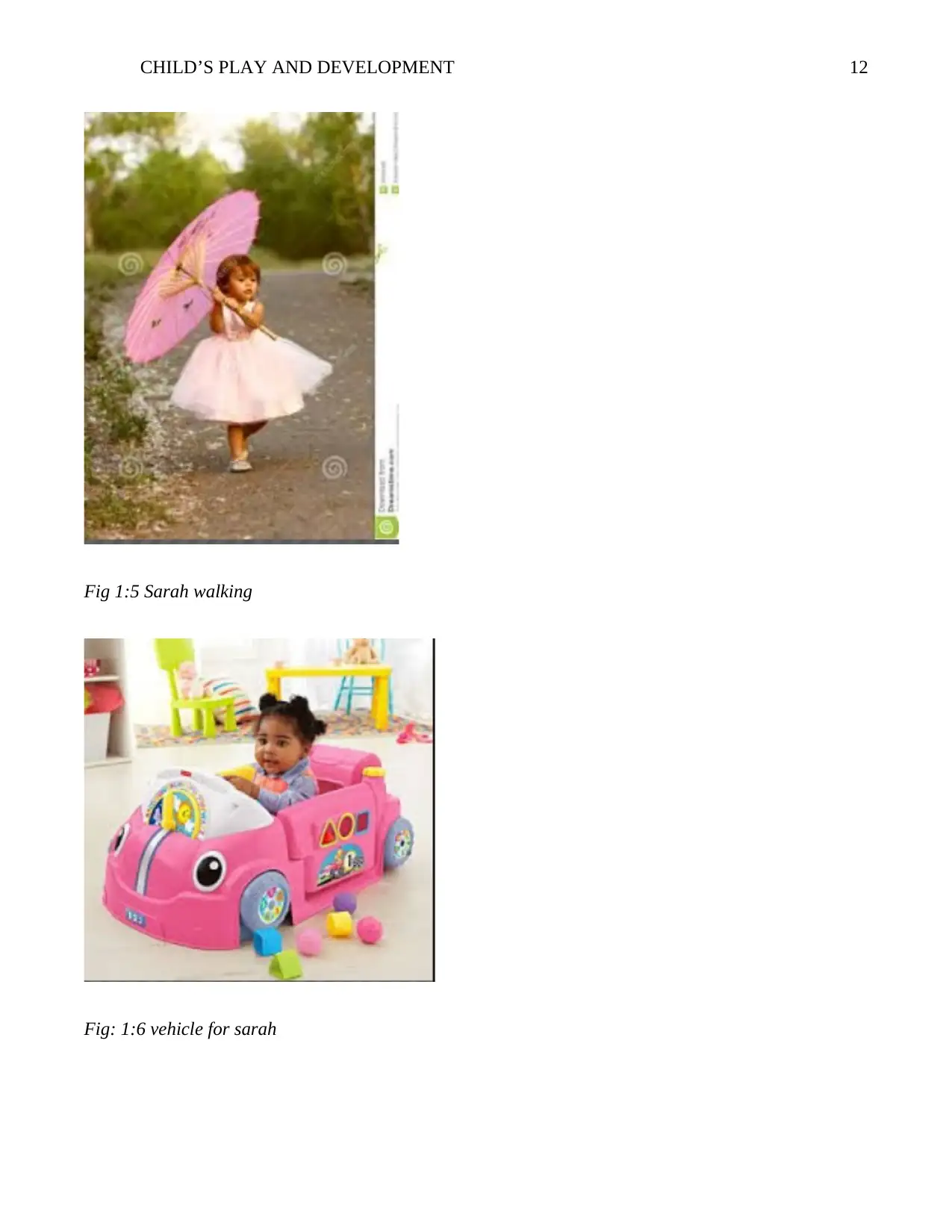
CHILD’S PLAY AND DEVELOPMENT 12
Fig 1:5 Sarah walking
Fig: 1:6 vehicle for sarah
Fig 1:5 Sarah walking
Fig: 1:6 vehicle for sarah
⊘ This is a preview!⊘
Do you want full access?
Subscribe today to unlock all pages.

Trusted by 1+ million students worldwide
1 out of 18
Related Documents
Your All-in-One AI-Powered Toolkit for Academic Success.
+13062052269
info@desklib.com
Available 24*7 on WhatsApp / Email
![[object Object]](/_next/static/media/star-bottom.7253800d.svg)
Unlock your academic potential
Copyright © 2020–2025 A2Z Services. All Rights Reserved. Developed and managed by ZUCOL.





